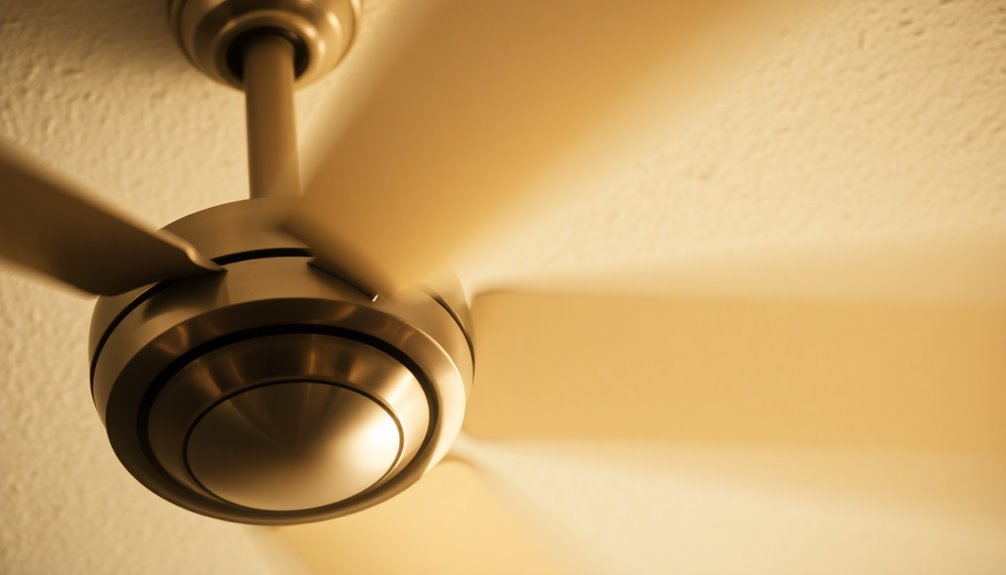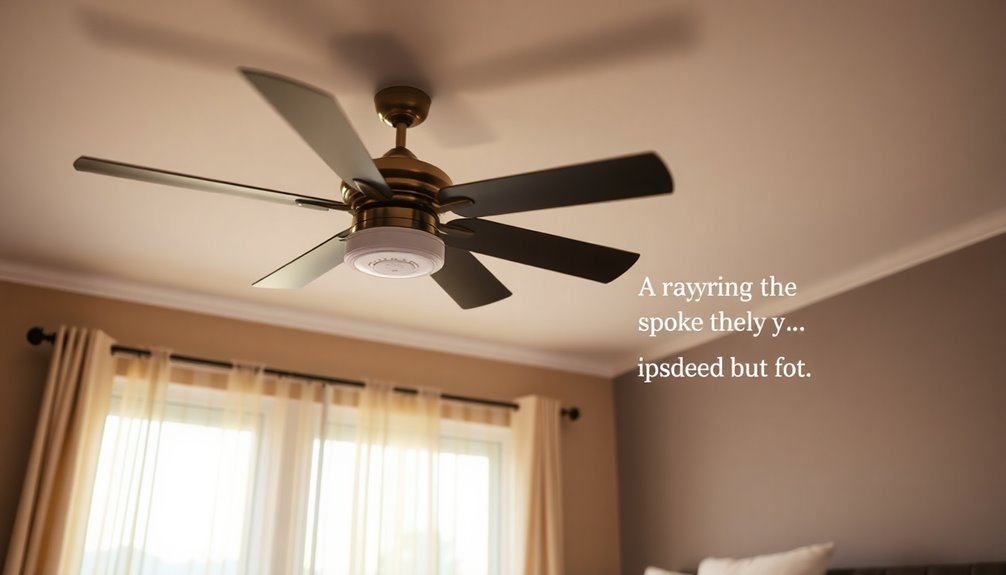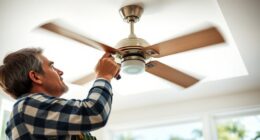If your ceiling fan shakes, it's usually due to loose screws, warped blades, or improper installation. Start by checking if the mounting bracket is secure and tighten all screws. Dust and dirt can add weight, further disrupting balance, so consider giving your fan a good clean. Inspect the blades for any warping or misalignment, as these can cause uneven rotation. If these fixes don't resolve the issue, you might be facing deeper problems that could require replacement. Keep exploring to discover effective solutions and guarantee a smooth operation for your fan.
Key Takeaways
- Loose screws on fan blades or mounting brackets can disrupt balance, causing shaking during operation.
- Warped or bent blades may result from temperature changes or wear, leading to uneven rotation and wobbling.
- Accumulated dust and dirt can add weight to blades, affecting their balance and creating instability.
- Improper installation or manufacturing defects can result in an unbalanced fan, causing excessive shaking and noise.
- Ageing fans over 10 years old often experience increased wobbling due to wear and potential structural issues.
Causes of Ceiling Fan Wobble

Understanding the causes of ceiling fan wobble is crucial for maintaining a comfortable environment in your home. One common culprit is loose screws securing the fan blades. If these screws aren't tight, they disrupt the balance of your ceiling fan, leading to unwanted shaking.
Additionally, warped blades can occur due to temperature changes or wear, causing uneven rotation and increased wobbling. Accumulated dust and dirt on your fan blades can also add weight, affecting the balance and resulting in a shaky operation. Regular cleaning can help mitigate this issue.
Moreover, improper installation can contribute greatly to wobbling. If the mounting brackets are loose or the ceiling box connections are faulty, your fan won't be securely anchored, leading to instability.
Lastly, sometimes the imbalance in fan assembly is due to manufacturing defects. If the fan blades aren't evenly shaped or aligned, you'll notice excessive shaking.
To prevent these issues, verify that all screws are tightened, blades are free of warping, and the fan is installed correctly. By addressing these causes, you can enjoy a smooth, wobble-free operation.
Initial Troubleshooting Steps

When dealing with a shaky ceiling fan, taking quick action can save you from further frustration.
Start by ensuring everything is securely in place, as that's essential for preventing a wobbly ceiling fan. Here are some initial troubleshooting steps you can take:
- Check the Mounting Bracket: Make sure the fan is securely mounted to the ceiling. If it's loose, it can cause instability and shaking during operation.
- Tighten Fasteners: Inspect all fasteners on the fan assembly, including screws and the mounting bracket. Loose components can lead to excessive movement, so tighten anything that feels loose.
- Inspect Light Fixtures: If your fan has attached light fixtures, verify they're securely fastened. Unbalanced or loose fixtures can add unnecessary weight and contribute to the fan's instability.
Blade Inspection and Adjustment

How can you guarantee your ceiling fan runs smoothly and quietly? Start with a thorough blade inspection.
First, measure the distance from the ceiling to the tip of each blade; uneven lengths can lead to wobbling during operation. Next, check the blade mounting screws for tightness—loose screws can cause instability and excessive shaking.
While inspecting, look for any bent blades. Even slight warping can disrupt the fan's balance and result in unwanted movement.
Make certain that the blades are properly aligned and parallel to each other; misalignment can create uneven airflow, further contributing to wobbling.
If you notice significant damage during your inspection, consider replacing the affected blades. This adjustment can restore proper functionality and minimize shaking.
Additionally, ascertain that all blades are securely attached and evenly spaced; this promotes a more stable operation.
Balancing the Fan

To balance your ceiling fan, you first need to identify any sources of imbalance in the blades.
Using a fan balancing kit, you can adjust the weights effectively to minimize wobbling.
Once you've found the right distribution, your fan will run smoother and quieter.
Identifying Imbalance Sources
A ceiling fan's shaking can often be traced back to a few common imbalance sources that are easy to identify and fix. Here are three key areas to check:
- Loose Screws: Inspect the screws securing the fan blades. If any are loose, tighten them. Even slight looseness can disrupt weight distribution and cause shaking.
- Warped Blades: Look at the blades for any signs of warping. Temperature changes or wear can lead to warped blades, which affects their ability to rotate evenly. If you notice any damage, consider replacing the affected blades.
- Dust Accumulation: Regularly clean your fan blades to prevent dust buildup. Dust can add extra weight and disrupt the balance, leading to further shaking.
Using a ceiling fan balancing kit can help you identify which blade might be causing the issue.
Make sure all blades are evenly spaced and measure their distance from the ceiling to maintain proper balance.
Adjusting Weights Effectively
After addressing the common imbalance sources, the next step is adjusting the weights effectively to achieve a smooth and stable ceiling fan operation. Start by using a blade balancing kit, which includes plastic clips and adhesive weights to help you balance a ceiling fan.
Here's a simple process to follow:
| Step | Action |
|---|---|
| 1. Attach a Clip | Place a plastic clip on the end of a blade to identify wobble sources. |
| 2. Observe the Fan | Watch the fan's operation to determine which blade needs extra weight. |
| 3. Secure the Weight | Once you find the best location, replace the clip with an adhesive weight to secure the balance. |
Keep in mind that a wobbly fan can often be fixed with these adjustments. After making changes, perform regular maintenance checks, especially after cleaning, to confirm your fan remains stable. This way, you can enjoy consistent performance and prevent future wobbling issues. By effectively adjusting weights, you'll not only enhance your ceiling fan's efficiency but also extend its lifespan.
Importance of Quality Fans

Investing in a quality ceiling fan is essential for ensuring a smooth and enjoyable experience in your home. High-quality fans are designed to minimize wobbling issues, providing you with a stable and efficient airflow.
Here are three key advantages of choosing a quality ceiling fan:
- Durable and Well-Constructed: Premium ceiling fans are built with better materials, which means they're less likely to suffer from wear and tear. You can enjoy long-lasting performance without frequent replacements.
- Reduced Wobbling Issues: Quality ceiling fans undergo rigorous testing and quality control, markedly lowering the chances of manufacturing defects that can lead to annoying wobbling. A stable fan enhances your comfort and peace of mind.
- Lower Maintenance Needs: By investing in a quality ceiling fan, you'll find that the maintenance needs are reduced compared to cheaper alternatives. This means less hassle and fewer adjustments over time.
Maintenance and Troubleshooting Tips

Keeping your ceiling fan in top shape involves regular maintenance and attention to potential issues that can lead to shaking. Start by dusting the fan blades frequently to prevent debris buildup, which can cause wobbling. Periodically check the alignment of the blades and verify all screws are tight and secure.
Monitor your fan's performance for any unusual noises or vibrations, as these can indicate deeper issues. Clearing the area around the fan is also essential; maintain at least a 30-inch clearance from nearby objects to optimize airflow and minimize shaking.
If you're still experiencing persistent shaking after these maintenance steps, a balance kit can help correct any imbalances. Here's a quick troubleshooting guide:
| Issue | Possible Cause | Solution |
|---|---|---|
| Wobbling | Misaligned blades | Adjust blade positioning |
| Excessive noise | Loose screws | Tighten all screws |
| Poor airflow | Obstruction around the fan | Clear surrounding area |
| Vibration | Unbalanced blades | Install balance kit |
| Persistent shaking | Deeper structural issues | Consult a professional |
Taking these steps can enhance your fan's performance and longevity.
When to Seek Replacement

If your ceiling fan continues to shake despite thorough maintenance and balancing efforts, it might be time to contemplate a replacement. A wobbly fan can indicate deeper structural issues that aren't easily fixable. Ignoring persistent shaking can lead to hazards like falling blades or electrical malfunctions, making safety a top priority.
Consider these signs that it's time for a replacement:
- Age: If your ceiling fan is older than 10 years and experiencing severe wobbling, it's often more cost-effective to invest in a new model.
- Unusual Noises: If your fan produces strange sounds along with the shaking, it might indicate significant wear or damage, suggesting that a replacement is sensible.
- Frequent Repairs: If you've tried cleaning, tightening screws, and using a balancing kit multiple times without success, it may be time to say goodbye to your old fan.
Upgrading to a new fan not only enhances performance but also reduces the likelihood of future wobbling.
Don't compromise on safety—if you're facing these issues, consider making the switch for peace of mind.
Frequently Asked Questions
How Do I Stop My Ceiling Fan From Shaking?
To stop your ceiling fan from shaking, first, check that all screws holding the blades and mounting bracket are tight.
Next, use a ceiling fan balancing kit to adjust the weight distribution.
Inspect the blades for any warping or damage, and verify the fan's installed correctly with enough clearance from nearby objects.
Regularly clean the blades to prevent dust buildup, which can cause imbalance and contribute to shaking while it's running.
Will a Ceiling Fan Fall if It Wobbles?
Did you know that about 10% of ceiling fans experience wobbling during their lifespan?
While a wobbly ceiling fan doesn't automatically mean it'll fall, persistent shaking can indicate underlying issues. It's essential to address severe wobbling promptly, as continued operation may stress the mounting hardware.
Regular maintenance, like tightening screws, greatly reduces the risk. So, keep an eye on your fan for unusual noises or excessive shaking to guarantee safety.
Is a Shaking Ceiling Fan Safe?
A shaking ceiling fan isn't safe, and you should take it seriously.
If it wobbles excessively, it could lead to damage or even detachment from the ceiling, posing a risk of injury. You need to inspect it for loose screws or unbalanced blades.
Don't ignore the issue, as continued operation can strain the motor and shorten its lifespan.
If you can't fix it, consider consulting a professional for help.
How Do You Fix a Vibrating Fan?
When your ceiling fan's vibrating like a leaf in the wind, it's time to take action.
First, tighten all the screws to eliminate loose connections. Then, check for warped blades that might be causing the imbalance. You can use a balancing kit to find the sweet spot for stability.
Don't forget to dust the blades regularly. If the shaking continues, consider calling a professional or think about replacing the fan altogether.
Conclusion
To sum up, addressing a shaking ceiling fan involves inspecting blades, balancing the unit, and ensuring quality components. By taking these steps, you can enhance performance, reduce noise, and extend the fan's lifespan. Remember, regular maintenance is key to preventing future issues, while knowing when to seek replacement can save you time and frustration. So, whether you're adjusting blades, balancing the fan, or investing in a quality model, you'll enjoy comfort and peace of mind in your space.









